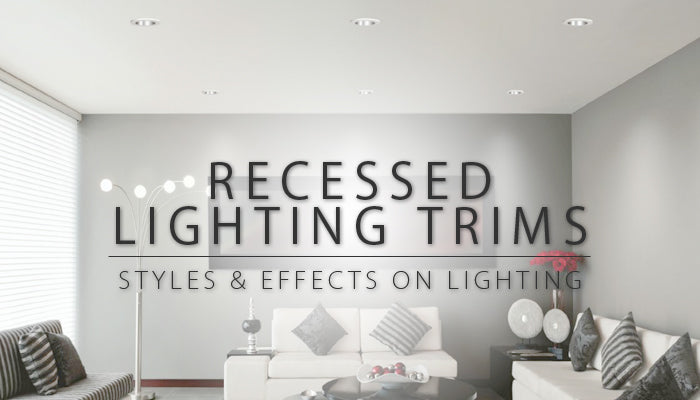
Recessed Lighting Trim Styles
Recessed lighting trim styles and their effects on lighting
Recessed lighting trims are used for three simple purposes:
- To conceal the lamp or housing behind them
- To direct and shape the beam of light
- To decorate the aesthetics of the environment
Although the reason to use recessed lighting trims is quite straight forward, choosing the right trim for your space is not quite as easy. There are many different types of trims, each providing different ways light is directed and cast into the surrounding environment.
So, let’s talk trim types and trim colors!
Trim Types
 |
Baffle trims are the most common types of trims for residential homes, often used for living rooms, dining rooms, and bedrooms. The inside surface of baffle trims are ribbed—featuring large uniform grooves designed to absorb and trap excess light. The lamp of baffle trims sit inside the trim minimizing glare and essentially softening bright light, making it more comfortable and less straining on the eyes. |
 |
Reflector trims are preferred in spaces where bright lighting is needed, such as kitchens, areas with high ceilings, and other commercial applications. Similar to baffle trims, lamps of reflector trims also sit recessed into the trim. However, unlike baffle trims, reflector trims have a highly polished smooth inside surface helping to maximize beam spread from light produced by the lamp. The inside surface is available in an assortment of tints, which help create a specific atmosphere to the room. Learn more about how trim color affects light output in the chart below. |
 |
In contrast to baffle and reflector trims, open trims are a simple ring flush around the lamp, exposing as much light as possible to the environment. Available in an assortment of colors as well, open trims are an economical choice. |
 |
Lensed trims have a plastic or glass lens that covers the lamp. The cover is designed to protect the light bulb and interior housing from moisture. This type of trim is most commonly used for bathrooms, showers, closets, and areas that are exposed to water or moisture. |
 |
Pinhole trims help concentrate the beam spread into a single cascading beam of light, similar to a spotlight. The precision provided by the pinhole trim is great for highlighting and drawing attention to displays and artwork located directly below the downlight. Baffled inside surface is also available to provide a softer beam spread. |
 |
Wall wash trims directs light onto the wall, minimizing texture on the surface and glossing over imperfections. The “eyelid” trim is perfect for covering a wall completely with light, and highlight artwork displayed on walls. To learn more about wall wash lighting, check out our previous post on wall wash lighting techniques. |
| Adjustable trims provide flexibility to direct lighting in any desired direction. Within the category of adjustable trims, there are different styles to choose from. Let’s take a look at each of them below: |
 |
Eyeball trims have a 30-degree tilt range and can rotate 360-degrees. They have the widest range of movement and adjustability. |
 |
Gimbal trims pivot 35-degrees and rotate 180-degrees. The lamp is not concealed and flush to the ceiling. Because the lamp is flush and does not protrude from the ceiling like eyeball trims do, when the lamp is tilted at full range the light beam may be cut off. |
 |
Retractable trims, also known as “elbow” or “scoop” trims, start flush at the ceiling and extend below the ceiling to 70-degrees. The capabilities of this trim are similar to that of a track light, just… without the track! They are great for directing light onto walls if the ceiling is sloped—allowing for a larger angle range than a typical adjustable trim. |
 |
Similar to gimbal trims, slot apertures provide a 35-degree tilt and 180-degree rotation. However, slot apertures completely conceal the lamp with a flat trim, so only a light beam can be seen. To make the light source even more discreet, trims can be painted the same color as the ceiling to hide fixture. |
| Lastly, decorative trims provide efficient lighting combined with aesthetically pleasing designs. | |||
 |
 |
 |
 |
Trim Colors
Trim colors play an important part to the aesthetics of your space; however, color of the trim also affects the efficiency of your light. Inside surfaces that are black absorb more light than those that are white. Black trims also help transition the light source into the ceiling making it barely visible. Take a look at the chart below to learn more about trim colors and light efficiency.
 |
View our full selection of Recessed Lighting – housings & trims – at LBCLighting.comHave questions regarding recessed lighting trims or recessed lighting in general?Please contact us at customerservice@lbclighting.com or give us a call at 626-279-2585. |
